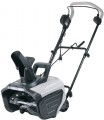Working width
The width of the strip of snow that the snow blower can clear in one pass. The larger the capture width, the fewer passes will be required to process the site, which is especially important on large areas. On the other hand, for processing small spaces, clearing individual paths, etc. significant width is not required (moreover, a “narrow” snow blower will pass more easily in a hard-to-reach place). The larger the capture width, the more powerful the engine, usually, ceteris paribus.
The most compact modern snow blowers have a working width of
less than 50 cm, these are mainly electric models of low power, although gasoline units are also found. A width of
50 – 60 cm can be called relatively small,
60 – 70 cm — medium, and in the largest models this figure
exceeds 70 cm.
Snow height
The maximum thickness of the snow layer that the snow blower removes in one pass. If you plan to regularly remove snow as it falls in a small area (for example, in the courtyard of your own private house), a grip height of up to 20 cm will be enough. If the opportunity to remove snow is rare (for example, in a country house where you visit only on weekends), you should pay attention to more powerful models with a height of about 50 cm.
Min. throw distance
The shortest distance that the snow blower can throw the collected snow.
The minimum range is indicated only for models with adjustable throw distance (see above). The meaning of this parameter is that in fact, long-range snow casting is not always desirable. For example, when clearing a path in the yard of a private house, snow often has to be poured literally next to the path, a little further — and it will fly onto the windows and walls of the house.
Note that the ejection range is a rather conditional value, because. snow (especially loose, freshly fallen snow) tends to dissipate in flight.
Max. throw distance
The maximum distance to which the snow blower can throw the collected snow (for models without throwing distance adjustment, the operating range itself). This value is rather arbitrary, since snow can be strongly dispersed in flight. Nevertheless, it characterizes the capabilities of the unit well and allows you to compare it with other models.
Long range is important mainly when working on large areas — it allows you to throw snow across the cultivated area so that it does not have to be collected a second time. As for specific figures, the value
up to 10 m is considered relatively small,
11 – 15 m — average, and in the most "long-range" models this figure can be
16 m or more.
Auger / brush diameter
The diameter of the working tool of the snow blower. Other things being equal (primarily engine power), a smaller diameter auger gives more force during rotation, and a larger diameter auger allows you to process more snow in the same time. Therefore, units with large augers can be recommended primarily for working with large volumes of relatively soft snow, and with small ones — for dense packed cover and crust.
Auger / brush rotation speed
The speed of rotation of the working tool of the snow blower.
Other things being equal, a higher speed is good for performance, a lower speed gives more torque and improves efficiency in hard snow and crust. However, in fact, this parameter is more of a reference than practically significant: manufacturers select the speed in such a way as to ensure sufficient efficiency and productivity. In addition, many models are produced with several gears, where the rotation speed can be adjusted.
Noise level
The average noise level produced by the snow blower during operation; the actual volume may differ slightly from this figure, but these deviations are usually negligible.
Note that snow blowers are quite loud equipment, plus the higher the power, the generally higher the noise level. This parameter is measured in decibels, this is a non-linear value, so the actual loudness is easiest to evaluate using comparative tables. So, the most "quiet" modern models give out about 55 – 60 dB — this can be compared with a conversation in slightly raised tones. 70 dB corresponds to a loud conversation, 80 dB to noise on a busy city street, 90 dB to a freight car at a distance of about 7 m, 100 dB to an industrial workshop, 110 dB to a tractor motor at a distance of 1 m.
The lower the noise level, the more comfortable this model will be to use. And according to sanitary standards, the maximum noise level considered safe for prolonged exposure (up to 8 hours) is 80 dB. So if the selected unit is noisier, and you plan to work often and for a long time, you should take care of protective headphones or earplugs.

